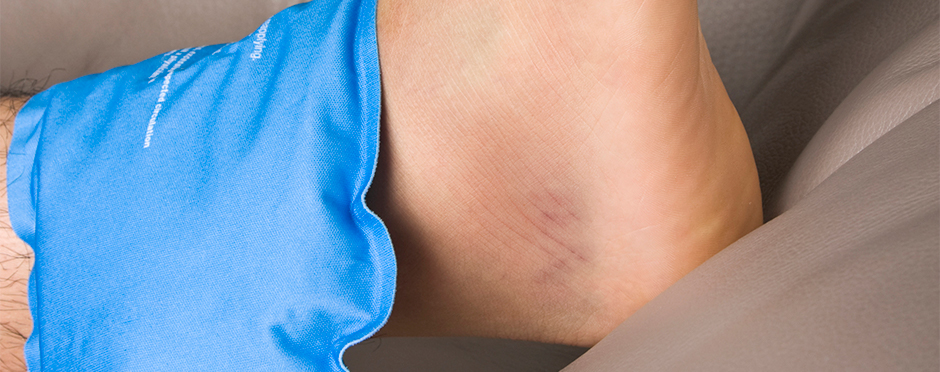
Should we take the “Ice” out of R.I.C.E.
2 CommentsR.I.C.E., which stands for rest, ice, compression and elevation, is an acronym familiar to many. Whether you are an “average Joe” or an athlete, coach, doctor, therapist or trainer it’s fairly common knowledge that if you are experiencing an acute soft tissue injury, R.I.C.E. is the standard operating procedure to get on track for a speedy recovery. As medicine becomes more evidence based we look to research to support much of our clinical decision making. Does current research still support the R.I.C.E. protocol?
Before we can decide if R.I.C.E. is effective let’s review its initial purpose. For many years it has been widely accepted that R.I.C.E. helps ease pain, decrease inflammation and swelling and accelerate healing and injury recovery. When tissue is injured it goes through 3 phases of healing:
- Inflammation- acute and essential phase of healing. When an injury occurs there is a buildup of excess blood, dead cells, and exudates which triggers inflammation cells to be released (macrophages and phagocytes) to clean up the resultant debris. The end result is a release of growth hormones (IGF-1, MGDF’s to name just a few) to help stimulate further healing.
- Proliferation- sub acute repair phase. The chemical response from the inflammation phase triggers a release of fibroblasts which promote healing and collagen formation. At the same time capillary networks increase throughout the injured region to help maximize healing through increased blood flow allowing oxygen and nutrients in and helping to remove metabolic waste products.
- Remodeling– late stage scar formation. In this phase collagen is laid down then reabsorbed and replaced by stronger collagen over time in response to tissue stress to form scar tissue.
The human body is remarkable with an innate ability to heal itself through the above mentioned phases. If these phases are the normal and necessary stages to achieve healing then it makes sense that we should not interfere or impede any of these processes. The acronym R.I.C.E. was created in 1978 by Dr Gabe Mirkin and has been widely adopted as a necessary first response to promote healing. Earlier this year, however, he wrote an updated article changing his view on R.I.C.E. and at the heart of the controversy are rest and ice. Per the doctor recent research suggests:
- Healing REQUIRES inflammation
- Ice keeps healing cells from entering injured tissue
- Anything that reduces inflammation also delays healing
- Ice reduces strength, speed endurance, and coordination
Below are three articles that stimulate some critical thinking about the complete rest and ice controversy for your review. These articles also site much of the current research supporting these new views.
People We’ve Got to Stop Icing Injuries. We Were Wrong Soo Wrong
Some points of interest I took away from these articles:
- Early controlled movement through pain free ranges, once you’ve been cleared of any serious injury, promotes healing rather than full immobilization or discontinuation of all activity. Movement encourages blood flow to damaged tissue which provides oxygen and nutrients for healing. It also stimulates the lymphatic system to help take all the garbage and even edema away from the injured area. In addition, movement causes some tissue stress which is necessary for collagen and scar tissue to build effective tensile strength as it heals.
- It is common to ice for 15-20 minutes, but some studies show tissue or even nerve damage in these ranges so 5-10 minutes of icing may be safer and is only recommended for 1-3 intervals on just the first day of injury. It is also suggested the tissue be fully re-warmed before return to any athletic activity or prior to another bout of icing.
- Inflammation is always portrayed as the enemy but in actuality it is a normal, natural, necessary and essential occurrence that promotes healing.
- Utilize compression whether it is from a wrap, a sock, or even a pump as it not only helps pain swelling, and improved motion but also aids circulation which in turn promotes healing.
The ice debate is a heated one likely due to its familiarity, ease and accessibility having strong proponents both for and against its use. Having used ice over the years on thousands of patients with what seemed like good results it is hard to make a paradigm shift against its use, but the above information is logical and compelling and further research is certainly warranted for this hot topic issue to decide if “ice” needs to be removed from the RICE equation. Do you have any interesting experiences or constructive thoughts for or against ice? Let us know in the comments below!

2 Comments
Michael Mitchell
Great and to the point article. Thank you!
Lori Diamos
Thanks Michael and glad you enjoyed the article.